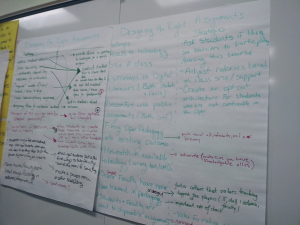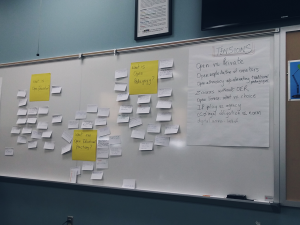In part one of Academic Success, we reviewed why it is important to help students develop time management skills and how to design courses that help students manage time. In this post, we will discuss the why, what and how about teaching students how to learn.
By this time, most public schools and higher education institutions are coming to a close for Spring 2020 teaching. Congratulations on overcoming so many challenges and finishing teaching during COVID-19! As we prepare for summer and/or fall teaching, I would like to invite instructors to consider teaching students how to learn in your next teaching adventure, in order to help students achieve academic success.
 Why Teach Students How to Learn?
Why Teach Students How to Learn?
For teachers, teaching students how to learn enables them to facilitate dramatic improvements in student learning and success (McGuire & McGuire, 2015).
For students, metacognition helps them to become self-aware problem solvers and take control of their own learning, through taking stock of what they already know, what they need to work on, and how best to approach learning new material (The Learning Center at UNC Chapel Hill, n.d.).
Teaching students how to learn also aligns tightly with the neuroscience of how humans learn. Dr. Daniela Kaufer pointed out four key learning principles based on the neuroscience of how people learn: (1). Learning involves changing the brain; (2). Moderate stress is beneficial for learning, while mild and extreme stress are detrimental to learning; (3). Adequate sleep, nutrition, and exercise encourage robust learning; and (4). Active learning takes advantage of processes that stimulate multiple connections in the brain and promote memory (Kaufer, 2011).
 What to Include in “Teach Students How to Learn”?
What to Include in “Teach Students How to Learn”?
Now we have seen why it is important to teach students how to learn from the perspectives of teachers, students and neuroscience, it is time to look into the content of a “Teaching Students How to Learn” training module. Dr. Saundra McGuire suggests getting students’ buy-in as a first step, through early diagnostic assessment which can be used to find out what students already know and what they did not know. Past examples of dramatic increase in assessment performance after receiving “Teaching Students How to Learn” training can also be an effective way to gain students’ buy-in. Secondly, Dr. McGuire suggests teaching students Bloom’s Taxonomy and study cycle to help students self-evaluate what they are learning and where to focus their learning at (the higher levels of learning, such as the applying, analyzing, evaluating and creating). The Study Cycle includes preview, attend, review, study and assess (Cook, Kennedy & McGuire, 2013). Thirdly, Dr. McGuire suggests sharing metacognitive learning strategies with students. The Learning Center at University of North Carolina at Chapel Hill lists eleven specific strategies that students can use to enhance their learning: (1) use your syllabus as a roadmap; (2) summon your prior knowledge; (3) think aloud; (4) ask yourself questions; (5) use writing; (6) organize your thoughts using concept maps or graphic organizers; (7) take notes from memory; (8) review your exams using test analyzer tool; (9) pause and ask yourself why you are doing what you are doing and how what you’re doing relates to the course as a whole and to the learning objectives that your professor has set; (10) test yourself; and (11) figure out how you learn and what learning strategies work best for you.
 How: Implementing “Teach Students How to Learn” in Online Course Design
How: Implementing “Teach Students How to Learn” in Online Course Design
There are many ways teachers and instructional designers can build activities and structures in course design to teach students how to learn. The following list is a starting point:
- Provide specific, measurable, attainable, result-focused and time-focused objectives at both course level and module level, and ask students how these objectives connect to their own learning interests and objectives, for example, using an ungraded survey/poll/private check in at the start of the term.
- Provide opportunities for students to reflect on prior knowledge they bring to the target topic/course
- Provide a list of questions to guide students for targeted reading and better reading comprehension as an active reading strategy, when assigning required readings materials.
- Provide questions in video lectures to help students check their understanding and keep students engaged;
- Release answer sheet to homework assignments after submission expires and provide opportunity for students to compare what they did right or wrong and how to get it right if they did it wrong initially, to achieve mastery learning;
- Provide opportunities for peer review and instructor feedback and make it possible for students to resubmit edited versions based on feedback received for mastery learning;
- Allow multiple attempts for assignments and assessments for mastery learning;
- Provide opportunities for students to reflect around midterm what learning strategies they use, whether they are effective or not, and how to adjust for better results in the reminding time of the course.
- Provide opportunities for students to reflect near the end of the term on what they learned and how they have learned, and how they might use the learning in their lives. For example, using discussion forum, google form survey, quiz or assignment to collect students’ reflective feedback.
The list can go endless. The point is there are many opportunities for teachers and instructional designers to build elements in course design to teach students how to learn! Feel free to share your ideas or experience of teaching students how to learn with us.
References
Cook, E., Kennedy, E., and McGuire, S.Y. (2013). Effect of Teaching metacognitive learning strategies on performance in General Chemistry Courses. Journal of Chemical Education, 2013, 90, 961-967.
Kaufer, D. (2011). Neuroscience and how students learn. University of California Berkeley Graduate Student Instructor Teaching & Resource Center. Retrieved from https://gsi.berkeley.edu/gsi-guide-contents/learning-theory-research/neuroscience/
McGuire, S. Y., and McGuire, S. (2015). Teach Students How to Learn : Strategies You Can Incorporate into Any Course to Improve Student Metacognition, Study Skills, and Motivation. First ed. Sterling, Virginia: Stylus, LLC.
The Learning Center, University of North Carolina at Chapel Hill. (n.d.). Metacognitive Study Strategies. Retrieved from https://learningcenter.unc.edu/tips-and-tools/metacognitive-study-strategies/
Resources on Neuroeducation
- Adolphs, R. (2009). The social brain: neural basis of social knowledge. Annual Review Psychology. 2009; 60: 693-716.
- Bransford, John., and National Research Council . Committee on Developments in the Science of Learning. How People Learn : Brain, Mind, Experience, and School. Expanded ed. Washington, D.C.: National Academy, 2000. Print.
- CAST (2018). UDL and the learning brain. Wakefield, MA: Author. Retrieved from http://www.cast.org/our-work/publications/2018/udl-learning-brain-neuroscience.html
- Doyle, Terry, and Zakrajsek, Todd. The New Science of Learning How to Learn in Harmony with Your Brain. Second ed. Sterling, Virginia: Stylus, LLC, 2019. Web.
- Eyler, J. (2018). How humans learn : The science and stories behind effective college teaching(First ed.), Teaching and learning in higher education (West Virginia University Press)). Morgantown: West Virginia University Press.
- Kaufer, D. (2011). Neuroscience and How Students Learn. Berkeley Graduate Student Instructor Center’s How Students Learn Series talk in Spring 2011. Retrieved from https://gsi.berkeley.edu/gsi-guide-contents/learning-theory-research/neuroscience/
- McLagan, Pat. “Unleashing the Unstoppable Learner.” Talent Development7 (2017): 44-49. Web. https://www.td.org/newsletters/atd-links/being-a-lifelong-learner
- Perkins, D. N., Goodrich, H. , Tishman, S. & Owen, J. M.(1994). Thinking Connections : Learning to Think and Thinking to Learn. Menlo Park, Calif.: Addison Wesley, 1994. Print.
- Schwartz, Daniel L., Tsang, Jessica M., and Blair, Kristen P. The ABCs of How We Learn : 26 Scientifically Proven Approaches, How They Work, and When to Use Them. First ed. New York, NY: W.W. Norton &, 2016. Print. Norton Books in Education.
- Südhof, T.C. (2013). Neurotransmitter release: the last millisecond in the life of a synaptic vesicle. Neuron. 2013 Oct 30;80(3):675-90. doi: 10.1016/j.neuron.2013.10.022.
- Tokuhama-Espinosa, Tracey (2011). Mind, Brain, and Education Science: A Comprehensive Guide to the New Brain-Based Teaching.New York: W. W. Norton.
- Ware, D. (2013). Neurons that fire together wire together. Retrieved from https://www.dailyshoring.com/neurons-that-fire-together-wire-together/










 The New Science of Learning
The New Science of Learning